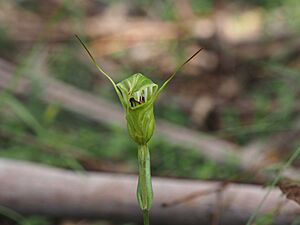Metcalfe's greenhood facts for kids
Quick facts for kids Metcalfe's greenhood |
|
|---|---|
 |
|
| Pterostylis metcalfei growing near Ebor | |
| Scientific classification | |
| Genus: |
Pterostylis
|
| Species: |
metcalfei
|
| Synonyms | |
|
|
Pterostylis metcalfei, often called Metcalfe's greenhood, is a special type of orchid. It's also known as the large kinked greenhood orchid or Ebor greenhood. You can only find this plant in the Northern Tablelands area of New South Wales, Australia.
Like other greenhood orchids, its look changes depending on if it's flowering or not. Plants that are not flowering have a group of leaves flat on the ground. But flowering plants grow a single flower with leaves on the flower stem. This greenhood has a unique dark green and white striped flower. It's only found in three places, which is why it's listed as an endangered species.
What It Looks Like
Metcalfe's greenhood has a group of 3 to 5 leaves. Each leaf is about 7 to 30 millimeters long and 7 to 20 millimeters wide. They are dark green and lie flat on the ground.
The flower stem grows about 10 to 30 centimeters tall. It holds one shiny flower that is greenish-white with darker green stripes. The flower is about 23 to 28 millimeters long and 9 to 11 millimeters wide. The top part of the flower, called the dorsal sepal, forms a hood over the flower's 'lip' (labellum). It has a thin, thread-like tip that is 7 to 14 millimeters long. The flower's lip is blunt and has a sharp bend in the middle. It's about 13.5 to 17 millimeters long and 3 millimeters wide. This orchid blooms from March to May.
How It Got Its Name
The Metcalfe's greenhood was first officially described by a botanist named David L. Jones in 1997. He found a sample collected by Peter Metcalfe in 1994. The plant's scientific name, metcalfei, honors Peter Metcalfe, who collected the first sample.
Where It Lives
This orchid only grows in the New England Tablelands (biogeographic region) at high places, from about 1000 to 1350 meters above sea level. It likes to grow on ridges and slopes where the soil drains well. You can find it among grass and shrubs.
It's only known from three locations. Just one of these places is in a national park. This means the orchid is at risk from things like cattle grazing and being stepped on.
Why It Needs Protection
Because it's so rare, the Metcalfe's greenhood is listed as an Endangered Species. This means it's at high risk of disappearing forever if we don't protect it. The Office of Environment and Heritage in New South Wales has officially recognized it as endangered.


